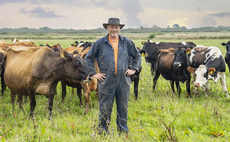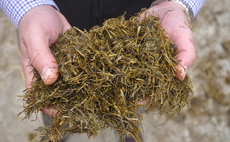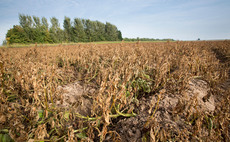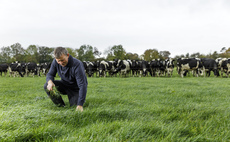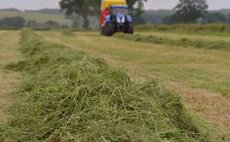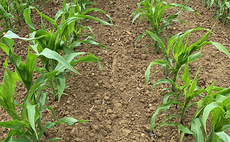
Crop and soil sampling results indicate sulphur deficiency is widespread and affecting a range of crops.
The fall in sulphur dioxide emissions to the atmosphere as a result of tighter environmental regulations and its impact on sulphur availability to crops is well documented. But while the proportion of UK oilseed rape and cereal crops receiving sulphur fertiliser applications has increased, along with the amount of sulphur applied, there are concerns too few crops receive sufficient sulphur to meet their requirements for yield and quality and a wider range of crops, including peas, beans and sugar beet, also have a requirement for supplementary sulphur.
Jon Telfer of Lancrop Laboratories has a unique insight into the nutrient status of soils, crops and organic manures in the UK and further afield, with the laboratory's database extending to 73 million results from samples of soil, grain, manures and digestates.
Deficiency
The lab's soil analysis results, for example, highlight the upward trajectory of sulphur deficiency, Mr Telfer told a technical conference on sulphur organised by ICL UK.
"Using our data going back - I first started counting in 1995 - we saw then about 60% of soil samples tested through the lab were below the guideline for sulphur. That test is pulling out sulphate and is not really targeting a huge amount of sulphur in soil - it works out, depending on the crop at about 15-20kg/hectare," Mr Telfer told the conference.
"Fast forward to the present day and looking at all the samples through the lab, we are reaching about 97% of samples below the guideline. We haven't changed the method and we haven't moved the guideline, so all we can take from that is that soil supplies of sulphur are exhausted."
There are a number of key opportunities for testing that can help monitor and manage the sulphur status of crops, suggested Mr Telfer.
He picked analysis of the sulphur content of any organic manures, including slurries and digestates, to be used as a starting point. However, while reliable values for NPK content of organic manures were available from sources, such as the RB209 Nutrient Management Guide, with average values provided in the guide more or less correlating with results seen from samples tested by the laboratory over time, there is evidence this was not always the case with sulphur values, said Mr Telfer.
"We are seeing an increasing amount of digestates through the lab, including a lot of digestate liquor. How does that stand up against RB209 book values? RB209 would suggest 1kg of S03 per cube [cu.m]. Well, I would suggest 99% of samples through the lab are not achieving this. At the application rates some of these digestates are going on at, that could multiply up, I would argue, to quite a shortfall."
Tissue
The next opportunity for testing for sulphur status was crop tissue analysis in the growing crop, suggested Mr Telfer.
"We should be doing tissue analysis at timely points during the season to adjust our inputs. Otherwise how do we know what to put in that spray tank or which micronutrient to add to that spray tank? The great thing about tissue analysis is it will give you a full nutrient report and sulphur is a part of that."
Analysis of leaf tissue testing results from samples of oilseed rape, wheat, sugar beet, peas, beans and maize tested by the laboratory between 2015 and 2019 highlights the failure of a significant number of samples to hit critical guideline levels for sulphur content, said Mr Telfer.
"A quarter of oilseed rape samples were not hitting the target. Interestingly, fertiliser usage statistics show a quarter of oilseed rape crops do not receive sulphur. Is there a connection?
"A third of cereals are not hitting the guideline. About half of pea and bean samples that come through the lab are not hitting guideline.
"To me there is a great synergy between usage rates and the rate of deficiency we see in the tissue samples through the lab."
Looking to other crops, 15% of sugar beet samples showed evidence of sulphur deficiency, as did 17% of maize samples.
"That is only against the critical guideline of 0.1% sulphur, it is not exactly a greedy level of sulphur we are looking for.
"Sulphur deficiency is being picked regularly by tissue analysis throughout the growing season."
Strategies
And there is further opportunity later in the season to assess if sulphur strategies are correct, in the form of grain analysis. In cereals this can be assessed by determining nitrogen:sulphur ratios, said Mr Telfer.
Commenting on grain testing results from harvests 2010 through to and including 2019, he said: "In cereals we are looking for a nitrogen:sulphur ratio of less than 17.1 and we tend to say we are looking for an optimum of about 14.1 On average, year-on-year, you could say we more or less hit that.
"Interestingly in the last two years we've seen a lower N:S ratio in grain samples, combined with a higher level of sulphur in tissue samples. I would argue it has a lot to do with the fact that we've had two pretty warm years, with warm soils, mineralising sulphur in organic matter into a sulphate form, combined with not a great deal of rainfall to leach it out again. And we picked that up in tissue samples right through last season. But is that the norm, or is that the exception? It is probably more the exception and even in a ‘good' year there are still plenty of samples not hitting the grade."
Key points
- Soil analysis results confirm the decline in soil supplies of sulphur
- Organic manures might not be delivering the expected amount of sulphur based on book values alone, but analysis will give a true value
- Timely use of leaf analysis will allow for early season adjustment
- Grain analysis can provide a useful end of season report
Lagging behind
Rothamsted Research scientist Prof Steve McGrath, who has been working on sulphur and crop nutrition for more than three decades, told the conference that, aside from cereals and oilseed rape, most other arable crops are lagging behind in terms of sulphur applications.
Sulphur applications to sugar beet have started to increase but applications to potatoes, peas and beans, despite a positive effect on nitrogen fixation, and grassland remain too low in terms of the percentage area being treated with sulphur.
Commenting on the quantity of sulphur being applied to crops, application rates for oilseed rape are now close to what is recommended at 70-80kg SO3/ha and for wheat 25-50kg SO3/ha, said Prof McGrath.
"Where sulphur is being used it is reaching what we think are the recommended amounts for yield," he added.
However, routine S fertiliser applications are needed for crop yield and quality in the UK, he advised. And with little residual effect from sulphur fertiliser, applications are required every year.
Agrii fertiliser manager Tom Land shared results of some of the agronomy business' trials work with polysulphate fertilisers. Polysulphate is a product naturally derived from polyhalite, which is mined in the UK by ICL.
The trials aimed to investigate autumn applications of sulphur applied as a polysulphate or PKplus base, compared with industry standards MOP + TSP.
Two applications were tested: a high rate autumn application of 600kg/ha of 0.20.20 and a lower rate of 150kg/ha of 0.20.20. Treatments were overlaid with straight N and NS top dressing.
The results showed a slight yield advantage from PKplus, delivering S, Mg and Ca compared to a TSP + MOP blend, with a spring application showing the most benefit. The work is set to continue during 2020 and 2021, said Mr Land.






